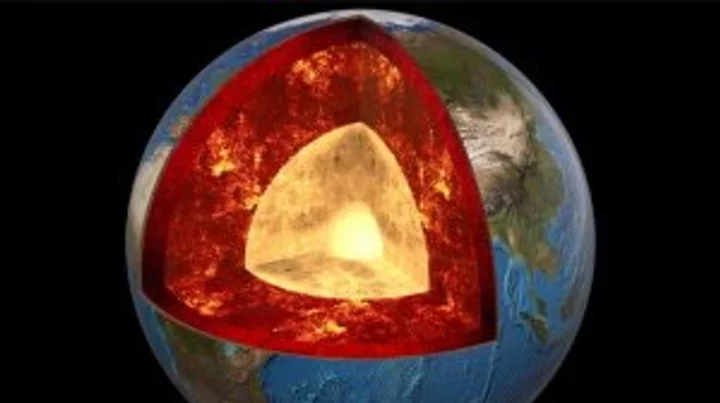
Scientists discover huge exoplanet 120 light years from Earth that ‘could contain signs of life’
An exoplanet more than eight times the size of Earth and potentially habitable has been discovered by scientists. Exoplanet K2-18 b was detected by NASA’s James Webb Space Telescope and piqued scientists’ interest after data suggested it may be covered in an ocean and have a hydrogen-rich atmosphere that could support life. Scientists are also encouraged by a hint of the detection of the molecule dimethyl sulphide (DMS). On Earth, DMS is only produced by microbial life, but the team has yet to confirm the detection and search for evidence of biological activity. The groundbreaking discovery of K2-18 b may see the exoplanet come under the unique classification of a “Hycean” planet – ones which are candidates for life thanks to their hydrogen-rich atmospheres and water cover. The amount of methane and carbon dioxide combined with the shortage of ammonia suggests there may be a water ocean underneath a hydrogen-rich atmosphere in K2-18 b. K2-18 b lies within the constellation of Leo and orbits a dwarf star called K2-18. It lies around 120 light years away from Earth and is within the habitable zone. However, scientists added that this does not necessarily mean it can support life. Nikku Madhusudhan, an astronomer at the University of Cambridge and lead author of the paper, explained: “Our findings underscore the importance of considering diverse habitable environments in the search for life elsewhere. “Traditionally, the search for life on exoplanets has focused primarily on smaller rocky planets, but the larger Hycean worlds are significantly more conducive to atmospheric observations.” Sign up to our free Indy100 weekly newsletter Have your say in our news democracy. Click the upvote icon at the top of the page to help raise this article through the indy100 rankings.
2023-09-12 17:29

Dollymania: When Dolly the Sheep Created a ’90s Media Sensation
Dolly the sheep was the first animal cloned from a single adult cell—and raised a lot of questions about the future of human cloning.
2023-09-12 02:26

10 Facts About Guinea Worm Disease
Dracunculiasis, or Guinea worm disease is, by all accounts, pretty awful: A person with the disease hosts a parasitic worm that forms a painful blister under the skin that eventually bursts, allowing the worm to emerge and lay its eggs in water. Those afflicted don't just endure pain (although there's plenty of that); they also run the risk of secondary infection and permanent paralysis, and there are economic consequences to the disease, too.
2023-09-12 00:21

Storm chasers capture frightening footage from inside Hurricane Lee
Storm chasers filmed the inside of a hurricane and it looks just as terrifying as you might imagine it would. The footage taken from inside the eye of Hurricane Lee was captured on Friday (8 September) as the storm moved over the Atlantic Ocean. The video taken shows lightning striking inside the Category 4 hurricane, illuminating the cloud wall around it and with the black eye overhead. The stunning clip was captured by the U.S. Air Force Reserve's 53rd Weather Reconnaissance Squadron in Biloxi, Mississippi. They are affectionately known as the “Hurricane Hunters”. As a Category 4 storm, Hurricane Lee has sustained winds of between 130 to 156 mph. The storm was located off the coast of Puerto Rico and was forecast to move northwards. The footage was able to be captured thanks to the squadron’s WC-130J Hercules aircraft. These planes are specifically designed for flying weather reconnaissance and have equipment onboard including sensors and instruments to measure the profile of a hurricane’s wind, temperature and pressure. The Hercules aircraft can stay airborne for up to 18 hours ensuring the crew onboard can record the weather data over a long time period. In a statement released by the U.S. National Oceanic and Atmospheric Administration's (NOAA) National Hurricane Center, they were unable to determine what the impact of the storm might be on the country’s eastern coast yet. The statement read: “It remains too soon to know what level of impacts, if any, Lee might have along the U.S. East Coast and Atlantic Canada late this week.” Hurricane Lee is the fourth hurricane to be recorded during the 2023 Atlantic hurricane season, along with nine other named storms. Sign up to our free Indy100 weekly newsletter Have your say in our news democracy. Click the upvote icon at the top of the page to help raise this article through the indy100 rankings.
2023-09-11 23:29

15 Sweet Facts About Sugar
9. Dogs have a sweet tooth, but cats don't.
2023-09-11 21:48

'Mountains' taller than Everest discovered on 'ancient structure' around Earth's core
A new study into the Earth beneath our feet has discovered that an ancient ocean floor structure could be wrapped around the planet's core which could be taller that Mount Everest in some areas. A brand new high-resolution mapping of the core has uncovered things that scientists previously didn't know according to a study that was first published in April. The discovery found that a thin but dense layer sits at around 2,900 kilometers below the surface at the Core Mantle Boundary where rocks meet the molten outer core of the planet. Geologist Samantha Hansen from the University of Alabama is quoted in the study saying: "Seismic investigations, such as ours, provide the highest resolution imaging of the interior structure of our planet, and we are finding that this structure is vastly more complicated than once thought." She adds: "Our research provides important connections between shallow and deep Earth structure and the overall processes driving our planet.” Hansen and her team conducted the research from 15 different stations in Antarctica by using seismic waves created by Earthquakes to create a map of what the inside of the planet looks like. The team identified the unexpected energy within seconds of the boundary-reflected wave from the seismic data. The findings show that although the layer is very thin it does spread for many, many kilometers and has been called the ultra-low velocity zone (ULVZs) due to its strong wave speed reductions. Due to the properties of the ULVZs the experts believe that the layer could vary dramatically in height. Geophysicist Edward Garnero from Arizona State University adds: "The material's thickness varies from a few kilometers to [tens] of kilometers. This suggests we are seeing mountains on the core, in some places up to five times taller than Mt. Everest." These underground mountains could play a significant role in how heat escapes from the Earth's core and power magnetic fields and volcanic eruptions. The team's studies suggest that the layer could encase all of the core but further research will have to be carried out to determine if that is the case. Sign up to our free Indy100 weekly newsletter Have your say in our news democracy. Click the upvote icon at the top of the page to help raise this article through the indy100 rankings.
2023-09-10 19:15

AC/DC: The Tesla–Edison Feud
You’ve probably heard about the famous rivalry between Nikola Tesla and Thomas Edison—both giants of electrical engineering whose innovations changed history. But what exactly was their history with one another?That whole boss/employee thing. Tesla, a Ser
2023-09-10 16:28
![What’s the Difference Between ( ), [ ], { } and < >?](/i/c/59c9f13e-6fd7-341f-77d2-d63fe03638cd.webp)
What’s the Difference Between ( ), [ ], { } and < >?
( )Parentheses (the single one is called a parenthesis), also known as curved brackets, have plenty of uses in everyday written language. Their most common use, as I’ve demonstrated already, is segregating subordinate material or asides. Usually, this is
2023-09-10 15:54

Underground 'mountains' discovered on Earth's core five-times taller than Mt. Everest
A new study into the Earth beneath our feet has discovered that an ancient ocean floor structure could be wrapped around the planet's core which could be taller that Mount Everest in some areas. A brand new high-resolution mapping of the core has uncovered things that scientists previously didn't know according to a study that was first published in April. The discovery found that a thin but dense layer sits at around 2,900 kilometers below the surface at the Core Mantle Boundary where rocks meet the molten outer core of the planet. Geologist Samantha Hansen from the University of Alabama is quoted in the study saying: "Seismic investigations, such as ours, provide the highest resolution imaging of the interior structure of our planet, and we are finding that this structure is vastly more complicated than once thought." She adds: "Our research provides important connections between shallow and deep Earth structure and the overall processes driving our planet.” Hansen and her team conducted the research from 15 different stations in Antarctica by using seismic waves created by Earthquakes to create a map of what the inside of the planet looks like. The team identified the unexpected energy within seconds of the boundary-reflected wave from the seismic data. The findings show that although the layer is very thin it does spread for many, many kilometers and has been called the ultra-low velocity zone (ULVZs) due to its strong wave speed reductions. Due to the properties of the ULVZs the experts believe that the layer could vary dramatically in height. Geophysicist Edward Garnero from Arizona State University adds: "The material's thickness varies from a few kilometers to [tens] of kilometers. This suggests we are seeing mountains on the core, in some places up to five times taller than Mt. Everest." These underground mountains could play a significant role in how heat escapes from the Earth's core and power magnetic fields and volcanic eruptions. The team's studies suggest that the layer could encase all of the core but further research will have to be carried out to determine if that is the case. Sign up to our free Indy100 weekly newsletter Have your say in our news democracy. Click the upvote icon at the top of the page to help raise this article through the indy100 rankings.
2023-09-09 20:24

Why was Only Up removed from Steam?
The viral gaming hit Only Up has been surprisingly removed from gaming platform Steam with the creator of the title citing "stress" as the reason. Only Up became a big hit with gamers on various streaming platforms earlier this year with players attempting to complete the seemingly easily but hard-to-master platformer which involved a character scaling various objects higher and higher into the sky. However, the game has now been pulled from Steam's storefront so it's creator who goes by the alias of SCKR Games can focus on their next title, which according to IGN has a codename of Kilth. In a statement, SCKR Games said that Only Up is "a game I did for creativity, to test myself, and where I made a lot of mistakes." They added: "The game has kept me under a lot of stress all these months. Now I want to put the game behind me." "What I need now is peace of mind and healing. I plan to take a pause, and continue my education in game design and further with new experience and knowledge to direct my energies to my next game with the working title ‘Kith’ — it will be a new experience and a new concept with realism, a completely different genre and setting, and the emphasis is on cinematography. “This time I hope the project will be created by a small team. This is a challenging project on which I want to significantly improve my skills in game design.” The game had been removed from Steam back in June and later returned in July after copyrighted assets from another developer managed to get into the game but was soon resolved. It's unknown whether the game will return to Steam at a later date but its page remains available on the website although it cannot be purchased. Sign up for our free Indy100 weekly newsletter Have your say in our news democracy. Click the upvote icon at the top of the page to help raise this article through the indy100 rankings.
2023-09-08 23:18

Scientists grow human kidneys inside a pig for the first time
Scientists have grown human kidneys in pigs, for the very first time. Researchers at the Guangzhou Institutes of Biomedicine and Health, Chinese Academy of Sciences and Wuyi University created human-pig chimeric embryos containing a combination of human and pig cells. When they transferred into 13 surrogate pig mothers, they developed kidneys that contained mostly human cells at a rate of 50 to 60 per cent, giving hope for potential transplants in the future. “Rat organs have been produced in mice, and mouse organs have been produced in rats, but previous attempts to grow human organs in pigs have not succeeded,” said the senior author Liangxue Lai. “Our approach improves the integration of human cells into recipient tissues and allows us to grow human organs in pigs.” The kidneys were not entirely human as they included vasculature and nerves made mostly from pig cells, meaning they could not be used for transplantation in their current form, but it is still a pretty impressive step. And apart from the kidneys, the embryos were dominated by pig cells, with very few human cells in the brain or central nervous system. Making brains using human and pig cells is very controversial for ethical reasons, so there are tight regulations for this kind of research. Meanwhile, pig cells tend to outcompete human cells during development, so previous experiments have created embryos that are almost entirely pig. The latest work, published in Cell Stem Cell, overcame this by genetically engineering a single-cell pig embryo so that it lacked two genes needed for kidney development. This created a gap within the embryo that could be filled by human cells. “We found that if you create a niche in the pig embryo, then the human cells naturally go into these spaces,” said Prof Zhen Dai of Guangzhou Institutes of Biomedicine and Health, another senior author. The scientists said that being able to incubate a fully human kidney inside a pig would be likely to take many years. “We would probably need to engineer the pigs in a much more complex way and that also brings some additional challenges,” said Miguel Esteban, also of the Guangzhou institute and a senior author. A central challenge would be to allow human nerves and vasculature to develop within the target organ without nerve cells developing in the central nervous system that could lead to a humanised brain. “Even theoretically it’s not clear how you’d do that,” said Ilic. Sign up to our free Indy100 weekly newsletter Have your say in our news democracy. Click the upvote icon at the top of the page to help raise this article through the indy100 rankings.
2023-09-08 19:56

Human embryo created without using sperm or eggs
Scientists in Israel have created a model of a human embryo from stem cells, without using sperm, eggs or a womb. A team at Israel's Weizmann Institute of Science made the model, which resembles an embryo at day 14, when it acquires internal structures but before it lays down the foundations for body organs, and the work was published in the journal Nature. But the scientists involved said it would take a long time yet to create an embryo from scratch. Team leader Jacob Hanna said the team took stem cells derived from adult human skin cells, as well as others cultured in the lab, then reverted the cells to an early state.They then manipulated them to make a model of an embryo, rather than an actual or synthetic one. "The question is, when does an embryo model become considered an embryo? When that happens, we know the regulations. At the moment we are really, really far off from that point," Hanna said. However, they said the work could open the door to new ways to test the effect of drugs on pregnancies, better understand miscarriages and genetic diseases, and maybe grow transplant tissues and organs. "They are not identical. There are differences from human embryos, but still, this is the first time, if you open an atlas or a textbook, you can say - yeah I can really see the similarity between them," said Hanna. "In about 1 percent of the aggregates we can see that the cells start differentiating correctly, migrating and sorting themselves into the correct structure, and the farthest we could get is day 14 in human embryo development," he said. Their next goal, Hanna said, is to advance to day 21 and also reach a threshold of a 50 per cent success rate. Magdalena Żernicka-Goetz, a professor of development and stem cells at the University of Cambridge, said the study joins six other similar human embryo-like models published from teams around the world this year, including from her lab. "None of these models fully recapitulate natural human development but each adds to ways in which many aspects of human development can now be studied experimentally," she said. Sign up to our free Indy100 weekly newsletter Have your say in our news democracy. Click the upvote icon at the top of the page to help raise this article through the indy100 rankings.
2023-09-08 18:19
